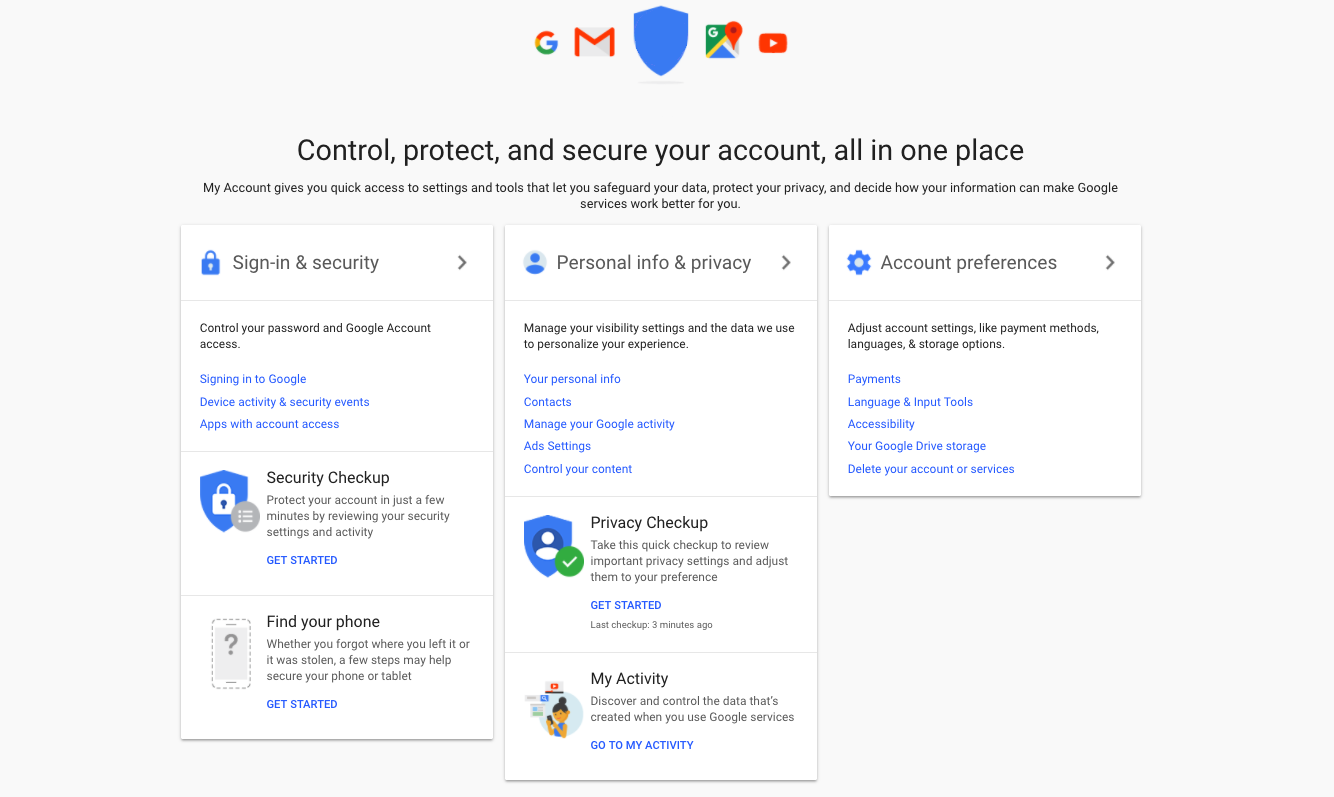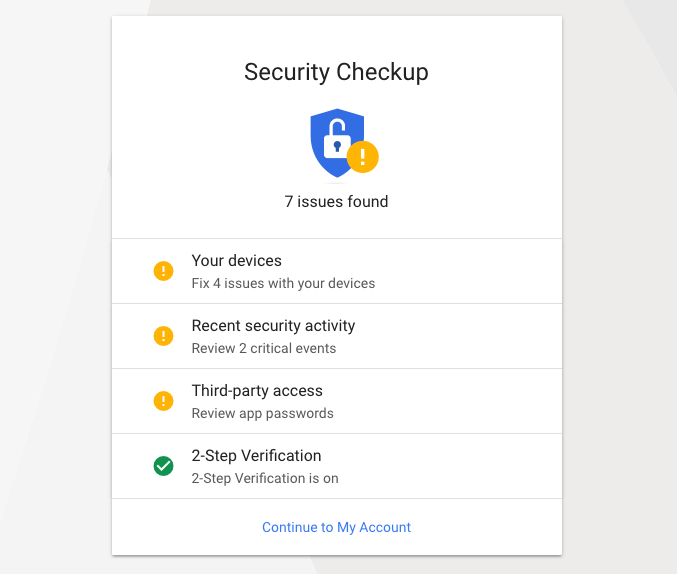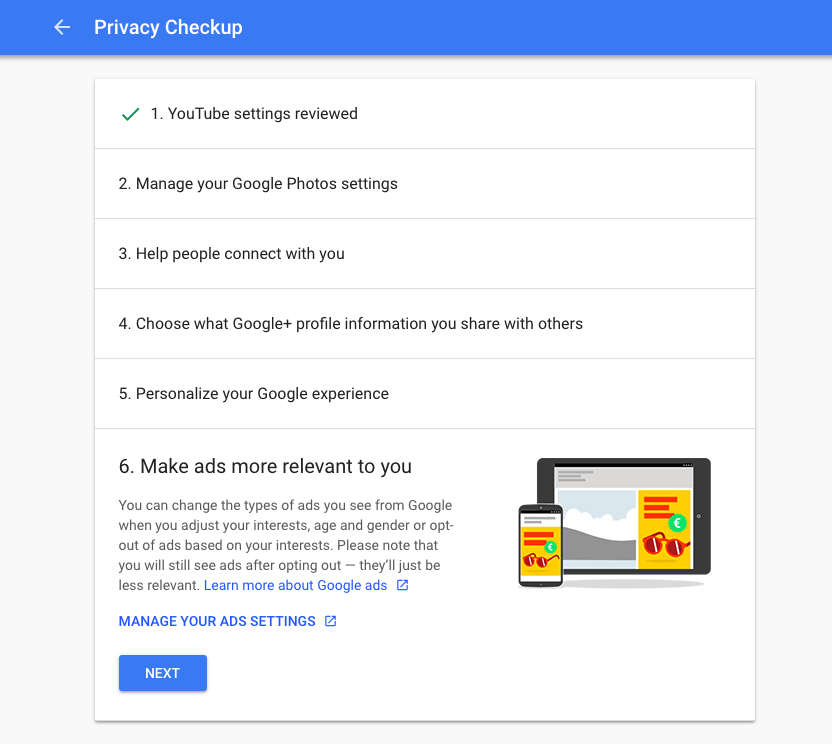
Facebook’s been dominating headlines lately for its massive privacy woes, but it’s not the only internet company that knows a whole lot about you. Google, through its various properties like YouTube, Gmail, and others, has some serious prying-power too. If you use Google every day — as I do — you’ve probably told the company more about you than you realize.
The good news is that Google is pretty proactive when it comes to getting you to lock down your information, and it has built-in tools to walk you through all the steps to secure your account.
Getting Started
Start by going to privacy.google.com. Scroll through the brief tutorial that explains what information Google collects and why. On the top of the screen, each little tab has additional details on topics like “Your Data,” “Your Security,” “How Ads Work,” and so on. It’s a nice little reminder of why you should keeping an eye on your security and privacy settings.
Taking Control
Once you’ve browsed through all of that information, click the link in the upper right-hand corner of the screen that says “My Account.” The next screen you see is your privacy and security headquarters for all of your Google accounts — that means Google, Gmail, YouTube, Google Maps, and more.

Now it’s time to take your “checkups.” Checkups are short guides that tell you what parts of your account are secure and what parts need your attention. Under the Sign-in & Security menu there’s a Security Checkup, and under the Personal Info & Privacy section, there’s a Privacy Checkup. Click “Get Started” on the Security Checkup.
You should see a list of security settings that you can tweak, and Google points out what you need to fix. Here’s a breakdown of what they do:

- Your Devices: Tells you if you have an account signed in to a device you haven’t used in a while. Click “Remove Account” to cut off access to your account from those devices.
- Recent Security Activity: Shows recent sign-ins from unrecognized devices, like phones or computers. Click “It was me” to tell Google if the gadget is yours, and if not, Google will walk you through resetting your password to lock down your account.
- Third-Party Access: Lists all apps that use your Google login and highlights high-risk apps that you should remove if you haven’t used them in a while.
- 2-Step Verification: Confirms that you have two-factor authentication set up for your account. If you don’t, it will prompt you to add it. Doing this will add an extra layer of security to your account.
Once you’re done, click “Continue to My Account” to go back to your security page and then click on the Privacy Checkup. The Privacy Checkup works a little bit differently, and instead of telling you what you should do, it will present you with a bunch of options to make your information public or keep it private. Each step addresses a different Google feature. Here’s how it breaks down:

- YouTube: Choose whether to keep video likes, subscriptions, and playlists private, and manage who gets notifications when you add a video to a playlist. You can also make videos private or unlisted.
- Google Photos: Decide whether to let Google’s facial recognition organize your pictures based on who is in them, and remove location data from photos shared with a link.
- Help People Connect With You: See what phone numbers Google knows you use and decide if you want to let Google use your phone number to help people find you when they search. I turn all this stuff off.
- Google+: If you ever set up a Google+ account, here’s where you can change who can see your photos, posts, and reviews. You can also specify that Google is not allowed to use any of your profile information or pictures for its products and services.
- Personalized Experience: Google uses a bunch of information about you to tweak your experience of using its apps and tools. Under this tab, you can switch off all of that, including web browsing activity, location tracking, voice and audio recordings, and YouTube searches and watch history.
- Ads: This tab explains what Google uses to serve you ads, and you can click on “Manage Your Ads Settings” to dive deeper into it and change things. Under the Ads Personalization page, you’ll see a lot of what Google knows about you, including your likes and dislikes, your age, and your gender. You can tweak these settings as you see fit, and remove items from your Likes and Dislikes lists if they don’t fit you, or if you don’t want Google to know that information.
Odds & Ends
Even after you’ve gone through both of your checkups, it’s a good idea to visit a couple of other spots in your security settings to make sure you’re protected. Head back to your My Account page and click on “Signing In To Google.” Here you can see how long it’s been since you last changed your password. Many security experts recommend changing your password frequently, so if it’s been over six months since your last password change, it’s a good idea to give it an update. On this same page, check your recovery email and phone number and make sure they’re up to date.
Back on the My Account page, click “Control Your Content.” You’ll see a couple of handy options including a link to download all of your Google data and a link to assign a trustee to your account. Downloading your data isn’t something you ever really have to do, but if you ever wanted just to grab all of the information Google has about you in one big folder, that’s where you can do it. Assigning an account trustee is also optional, but it’s not a bad idea. This lets family members shut down your account if anything were to ever happen to you. It’s not fun to think about, but it’s still pretty important.
